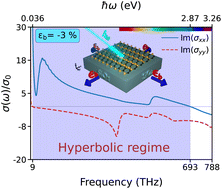Strain engineering of hyperbolic plasmons in monolayer carbon phosphide: a first-principles study
Abstract
Natural and tunable in-plane hyperbolic plasmons have so far been elusive, and hence few two-dimensional hyperbolic materials have been theoretically and experimentally discovered. Here, comprehensive first-principles calculations were conducted to study the electronic and plasmonic properties of biaxially strained monolayer carbon phosphide (β-CP). We found that (i) a compressed β-CP hosts strong anisotropic Dirac-shaped fermions with robust modulated Fermi velocity, (ii) for biaxial strain of −3% an unprecedented ultra-wide hyperbolic window is extended continuously from terahertz (9 THz) to mid-visible (blue light, 693 THz), (iii) the tunable optical Van Hove singularity as the origin of hyperbolic plasmons in deformed β-CP is disclosed, (iv) an elliptic to hyperbolic transition in the σ-near-zero regime is demonstrated in terahertz frequencies (9 THz), (v) the propagation angle of the concave wavefront can be actively tuned using biaxial strains, and (vi) hyperbolic dispersion reorientation from one principal axis to another orthogonal one under compressive strains larger than 8% is observed. This study sheds new light on the unique properties of hyperbolic two-dimensional (2D) materials having exotic optoelectronic characteristics which are promising candidates for anisotropic light control with ultimate dexterity in the flat optics.



 Please wait while we load your content...
Please wait while we load your content...